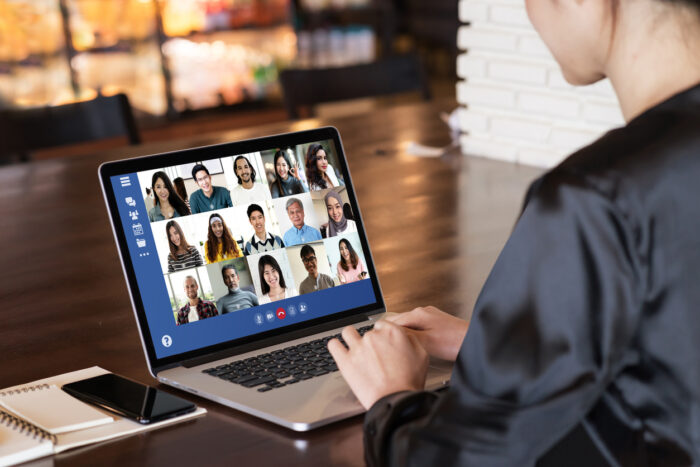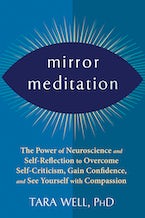By Tara Well, PhD, author of Mirror Meditation
The rise of Zoom has created unprecedented changes in how we communicate—and how we see ourselves and each other. As a result, our relationship to our own reflection has undergone massive changes in the past two and half years. Maybe you found looking at yourself to be yet another stressor. It’s even been called “mirror anxiety.”
There are a few reasons why you might find Zoom to be stressful and exhausting.
1. Zoom Simulates Intimate Interpersonal Contact
“Zooming” involves long stretches of direct eye gaze and faces seen close up, which simulates intimate interpersonal contact. So, we interact with casual acquaintances, coworkers, and even strangers in ways we typically reserve for our closest relationships. Of course, the size of faces on a screen depends on your computer monitor’s size, how far you sit away from your monitor, the view configuration you choose on Zoom, and how many faces are in the grid. But generally, the size of the person’s head is much larger than it would be if you had an in-person, face-to-face conversation.
In face-to-face conversations that take place in person, we use direct eye contact sparingly.
Even if the meeting doesn’t feature a third object to look at, like a PowerPoint screen, two speakers will spend most of the interaction averting their gaze from each other. Of course, the amount of gaze in a face-to-face social interaction depends on many contextual factors. These adjustments are impossible to make on Zoom.
2. We Have to Work Harder When Sending and Receiving Signals over Zoom
In face-to-face interactions, nonverbal communication flows with effortless and incredibly complex synchrony that usually happens outside of our awareness. On Zoom, nonverbal behavior remains complex, but research finds that we need to work harder to send and receive signals, creating an increased cognitive effort.
On the sending side, we must consciously monitor our nonverbal behavior and send cues to others that are more intentional. For example, we tend to smile more and speak louder in video interactions than in person.
Another source of extra cognitive effort relates to receiving cues. In a face-to-face conversation, we draw tremendous meaning from the head and eye movements, which signal turn-taking, agreement, and many emotional cues. On Zoom, these movements are largely out of context. For example, a quick sideways glance in a face-to-face meeting has a particular meaning, and a third person watching is likely to understand its meaning. On Zoom, you might see a pattern in your grid that seems like one person glanced at another. But this is probably not what happened because we often don’t have the same grids. Even if the grid were held constant, it’s more likely that a sudden glance indicates the person noticing a calendar reminder or a chat message that suddenly popped up on their screen. We constantly receive nonverbal cues that would have a specific meaning in a face-to-face context, but have different meanings on Zoom.
We may adapt to this over time. However, it’s good to acknowledge that it still takes effort to overcome our automatic reactions to nonverbal cues. Therefore, try not to evaluate yourself or others based on nonverbal cues alone. Especially if these evaluations and assumptions are negative; they are likely to be incorrect.
3. We Spend Too Much Time Looking at Ourselves, Feeling Self-Critical
As Zoom users, we see reflections of ourselves more often and for more extended periods than ever before. However, without the proper mindset, looking at one’s own image is likely to activate an uncomfortable level of self-consciousness, reducing the ability to concentrate, generating self-criticism, and creating a general sense of awkwardness. One way is to shift your attention from looking at yourself to focusing on others. You can do this by minimizing your self-view, or even hiding it.
Though you’ll always have the option of hiding from your own image (and hiding from others), a better long-term strategy might be not to avoid looking at yourself but to change the way you see yourself.
Here are some tips that can help you get comfortable seeing yourself on video calls:
1. Before a video call or in-person meeting, take a few minutes to connect with yourself in the mirror.
Look into your own eyes and do some reassuring self-talk. Try to keep it simple and honest, like: “I see myself, and others see me, and it’s OK.” “I will be kind to myself during this meeting.” “I am OK with who I am.”
2. As you look in the mirror, create a soothing gesture, something that no one else will notice.
Like tapping your forefinger and thumb together or gliding your thumb across your fingertips, gently touching your shoulder. This gesture can help you remember to be kind to yourself.
3. Do some three-part deep breathing, expanding your belly, ribcage, and collarbone, then gently contracting your collarbones, ribcage, and abdomen.
We often hold our breath to stop from feeling—take a moment to feel and connect with yourself.
4. Connect with your physical body.
Feel the pressure of your feet on the ground, the texture of your clothes against your skin, the air brush against your cheek. When you’re a bit anxious, you can lose touch with yourself, increasing discomfort.
5. Shift your focus outward.
If you feel self-conscious, it’s because you’re focusing on yourself. Shift your attention outward as you interact with others, and don’t worry about what you look like to them.
Zoom is a wonderful tool for facilitating communication. It can also help improve your relationship with yourself. If seeing your reflection reminds you that you’re stressed or anxious, you can use mirror meditation to calm yourself. If seeing your own reflection brings out your inner critic, use it as an opportunity to examine these self-critical thoughts and transform them with a little self-compassionate attention.
Tara Well, PhD, is associate professor of psychology at Barnard College of Columbia University in New York, NY, where she developed a mirror-based meditation called “a revelation” in The New York Times. As an expert on self-awareness, body image, self-compassion, emotional resilience, and meditation, Well has appeared on NBC Nightly News and has been quoted in The New York Times, The Boston Globe, The Washington Post, Bloomberg, Vice, Forbes, Harper’s Bazaar, Shape, Allure, and other media publications. In 2019, she gave the TEDx Talk, “What Mirror Meditation Can Teach You.” Her blog, The Clarity on Psychology Today, has more than a million readers. You can learn more about Well at www.mirrormeditation.com.



 2024 Peace Playbook: 3 Tactics to Avoid Clashes with Your Partner
2024 Peace Playbook: 3 Tactics to Avoid Clashes with Your Partner